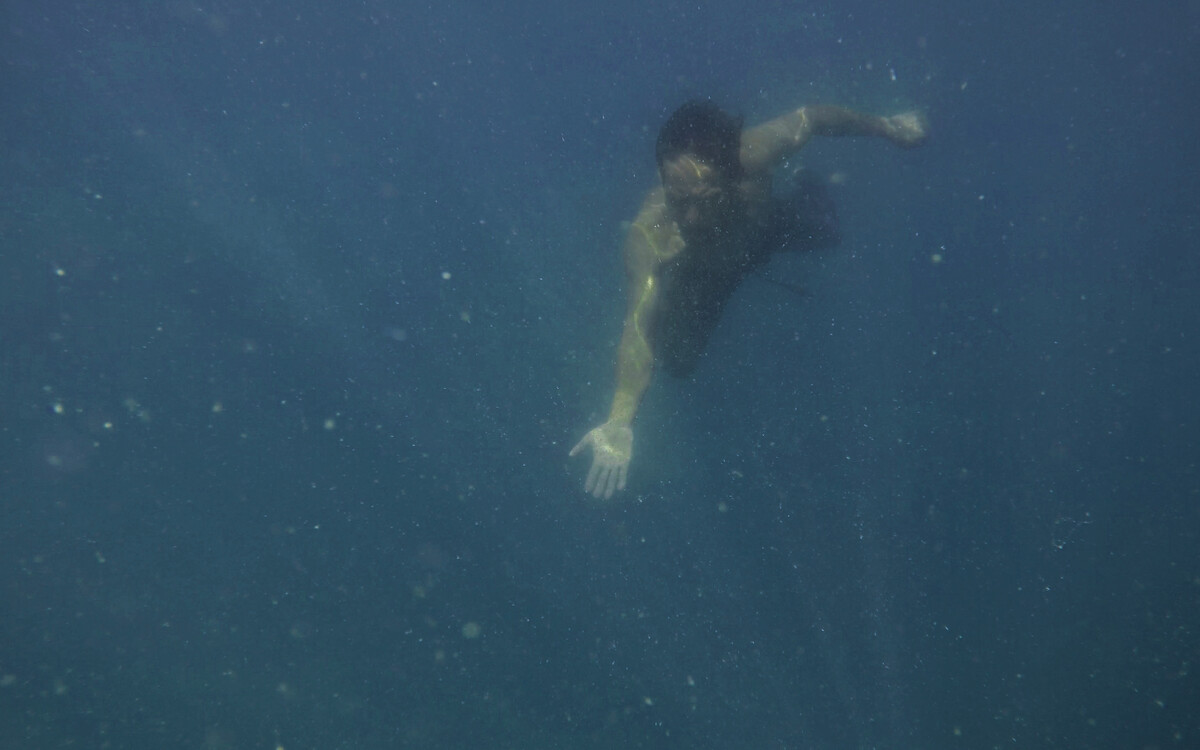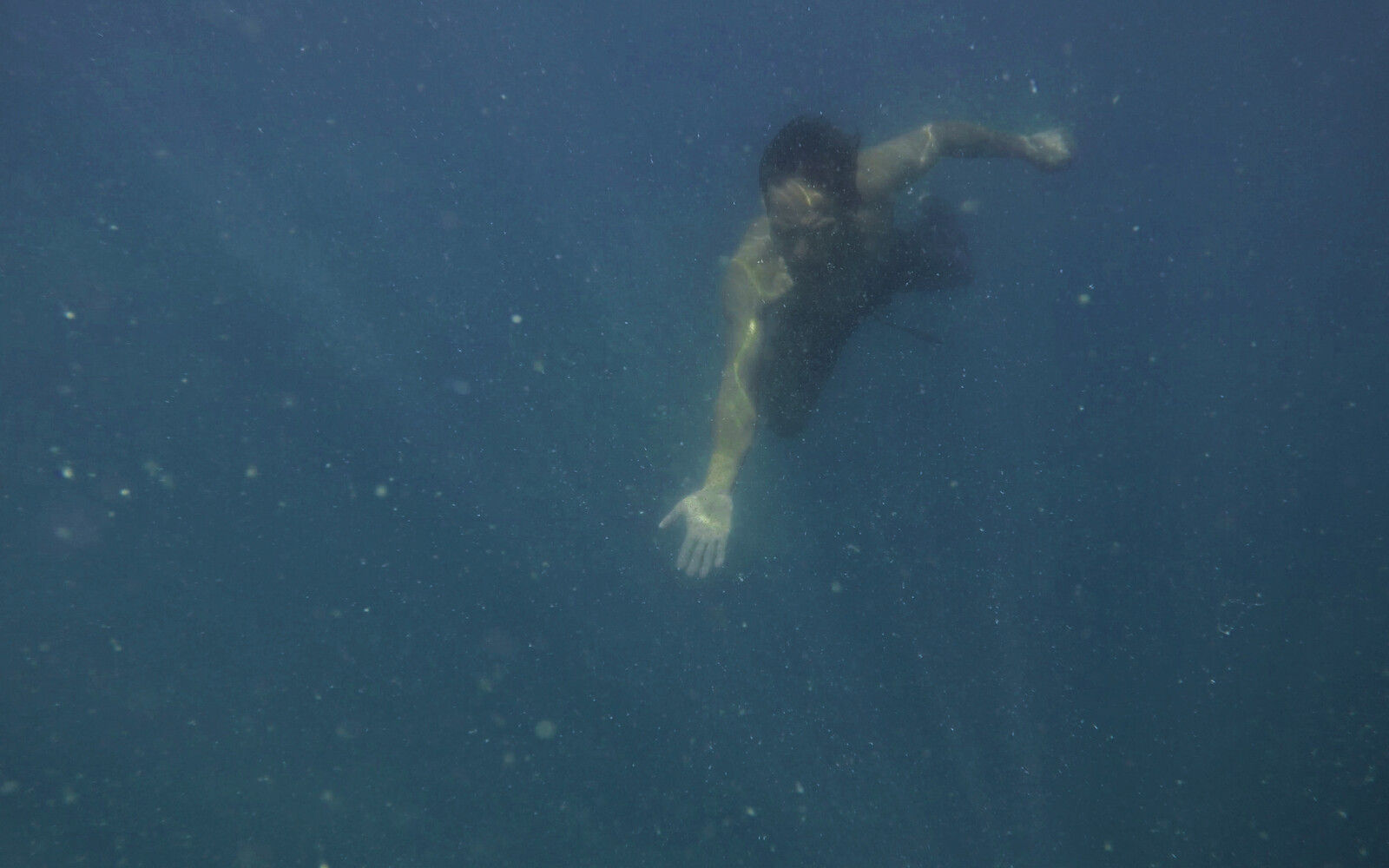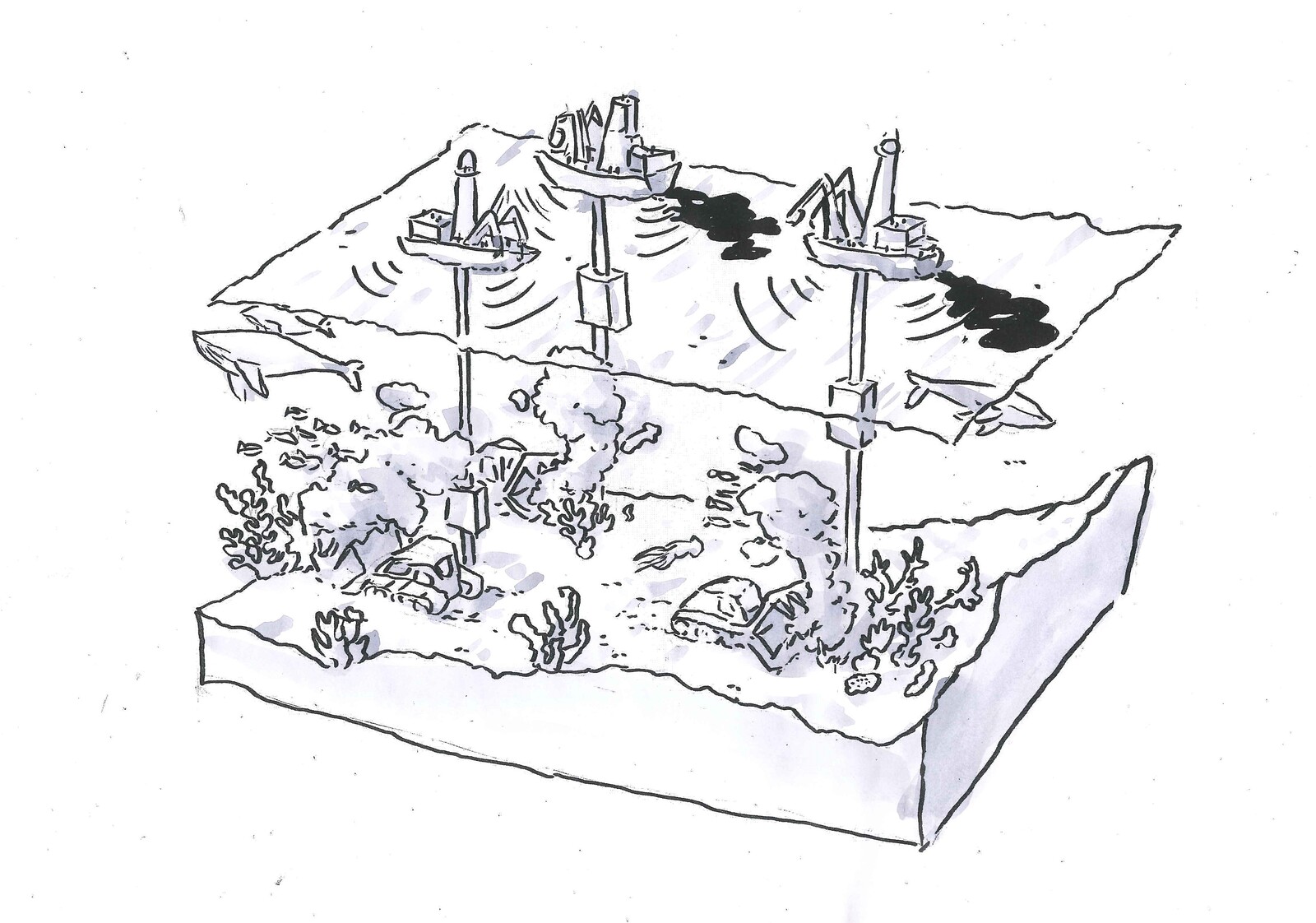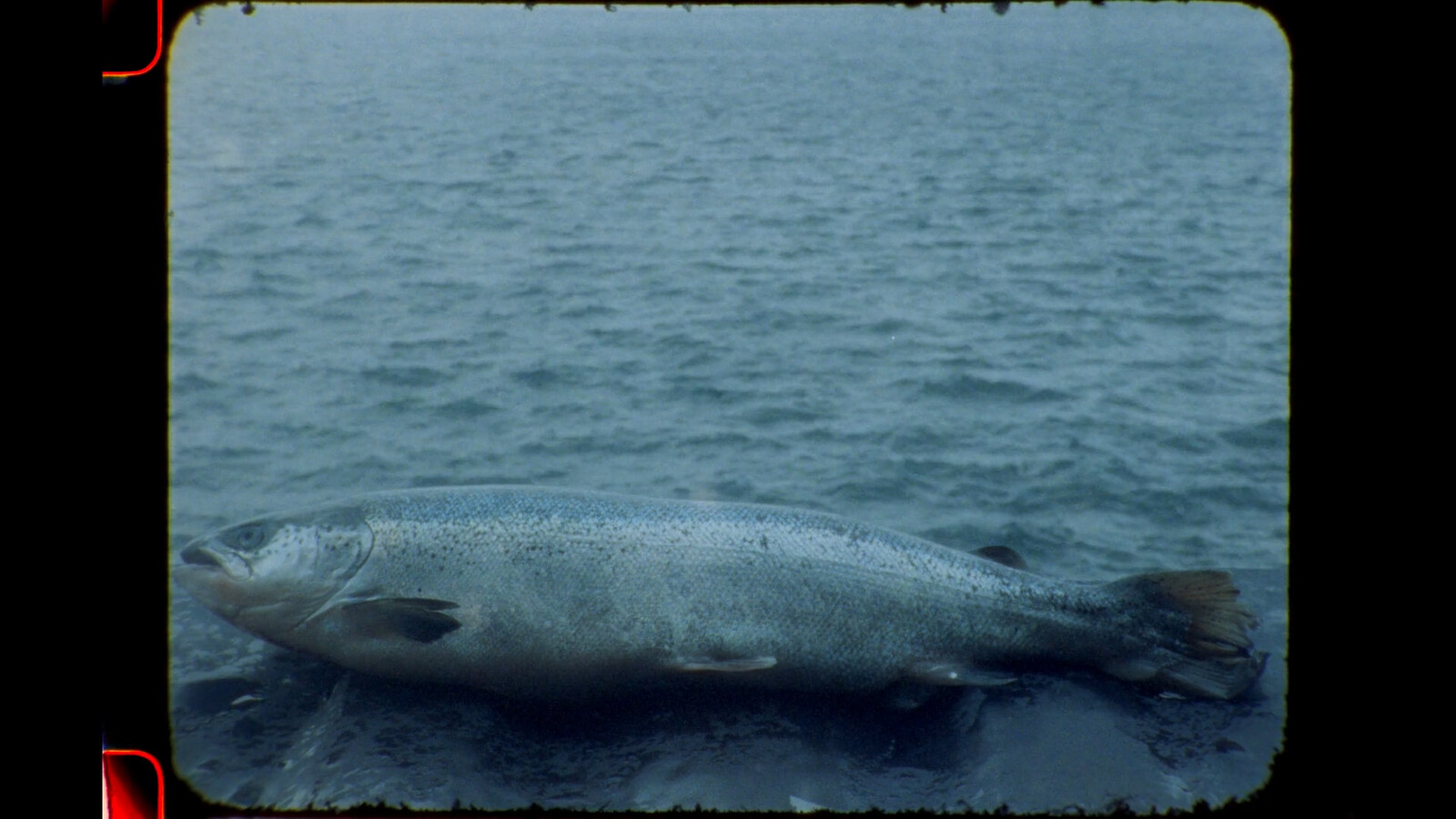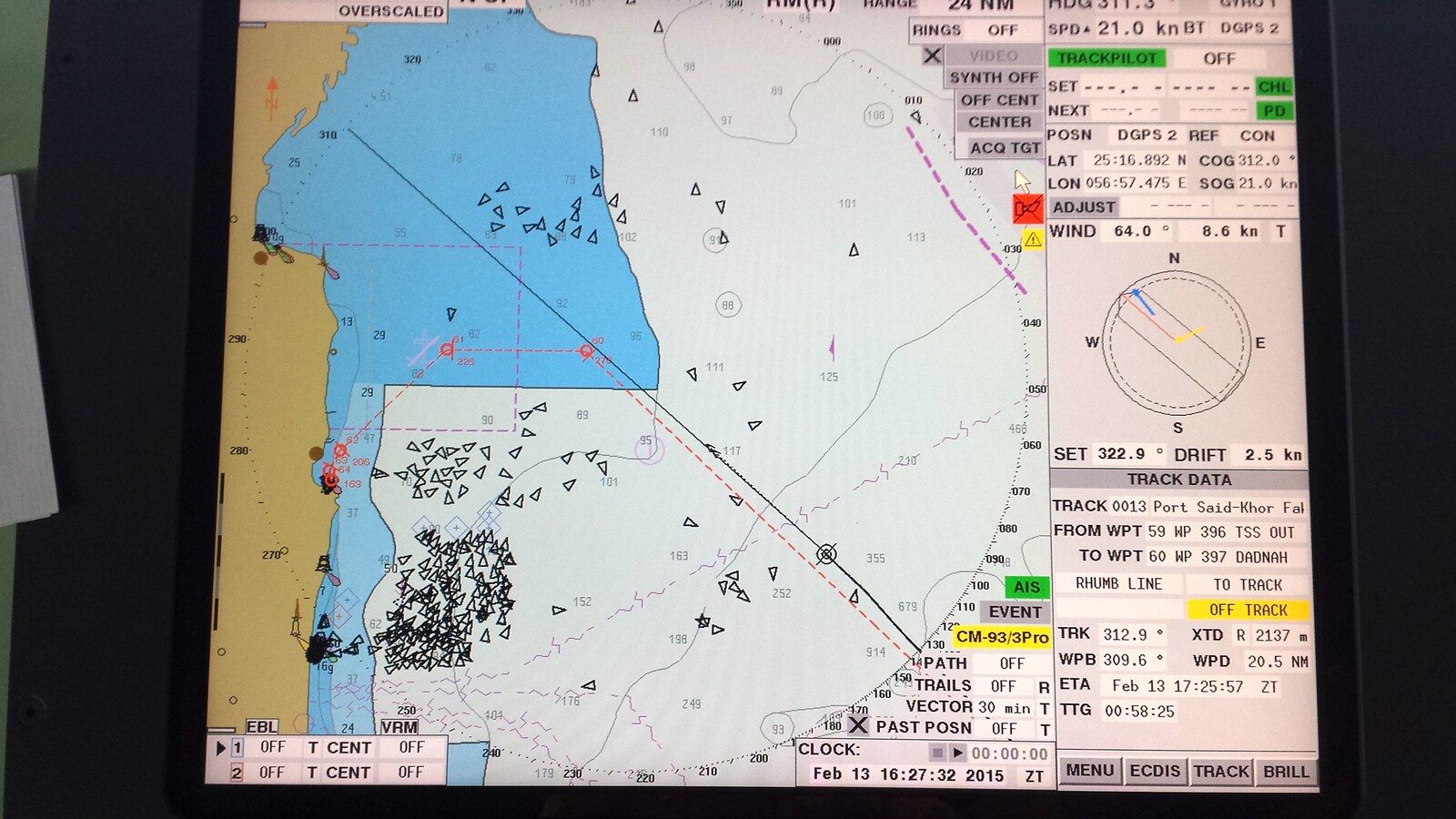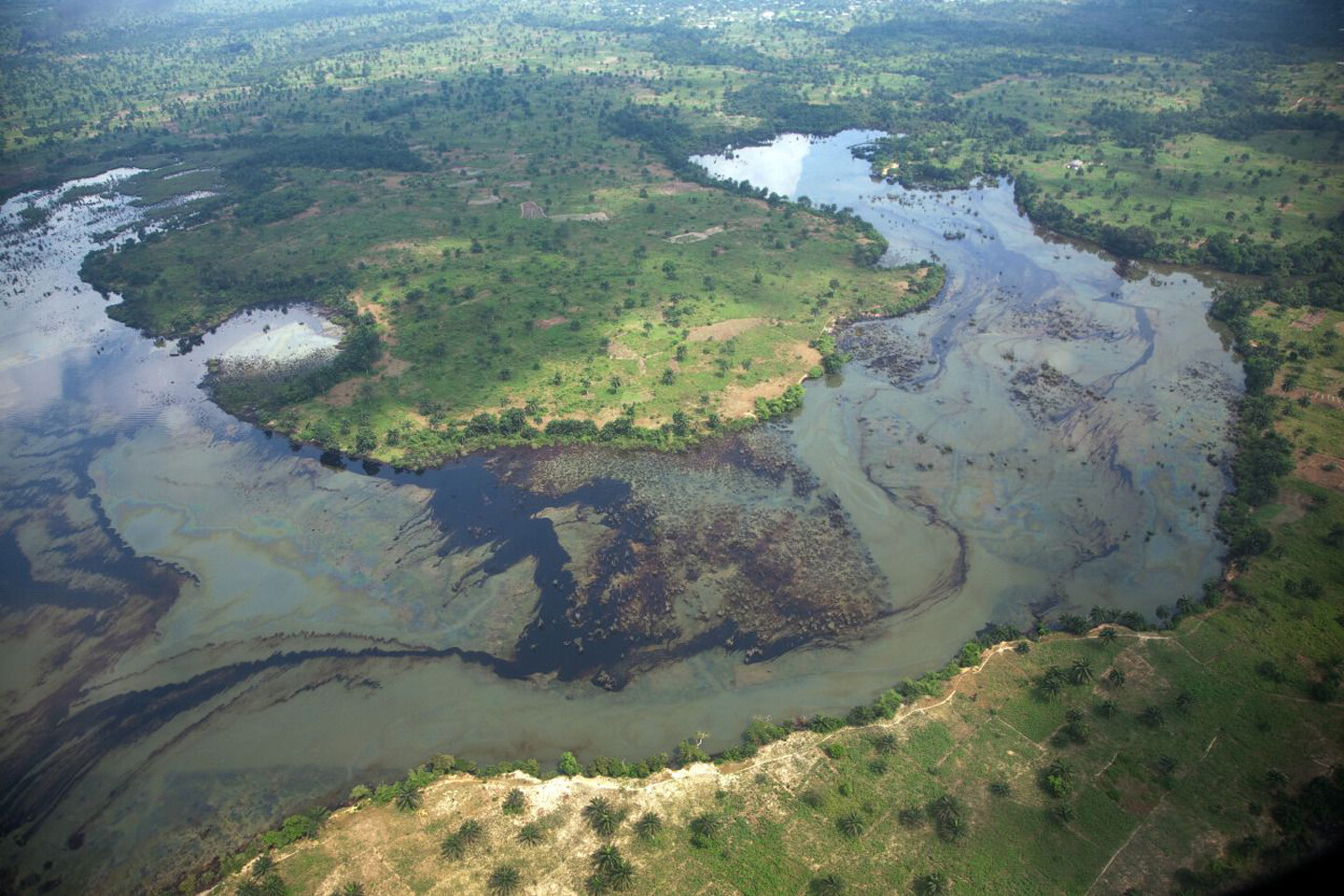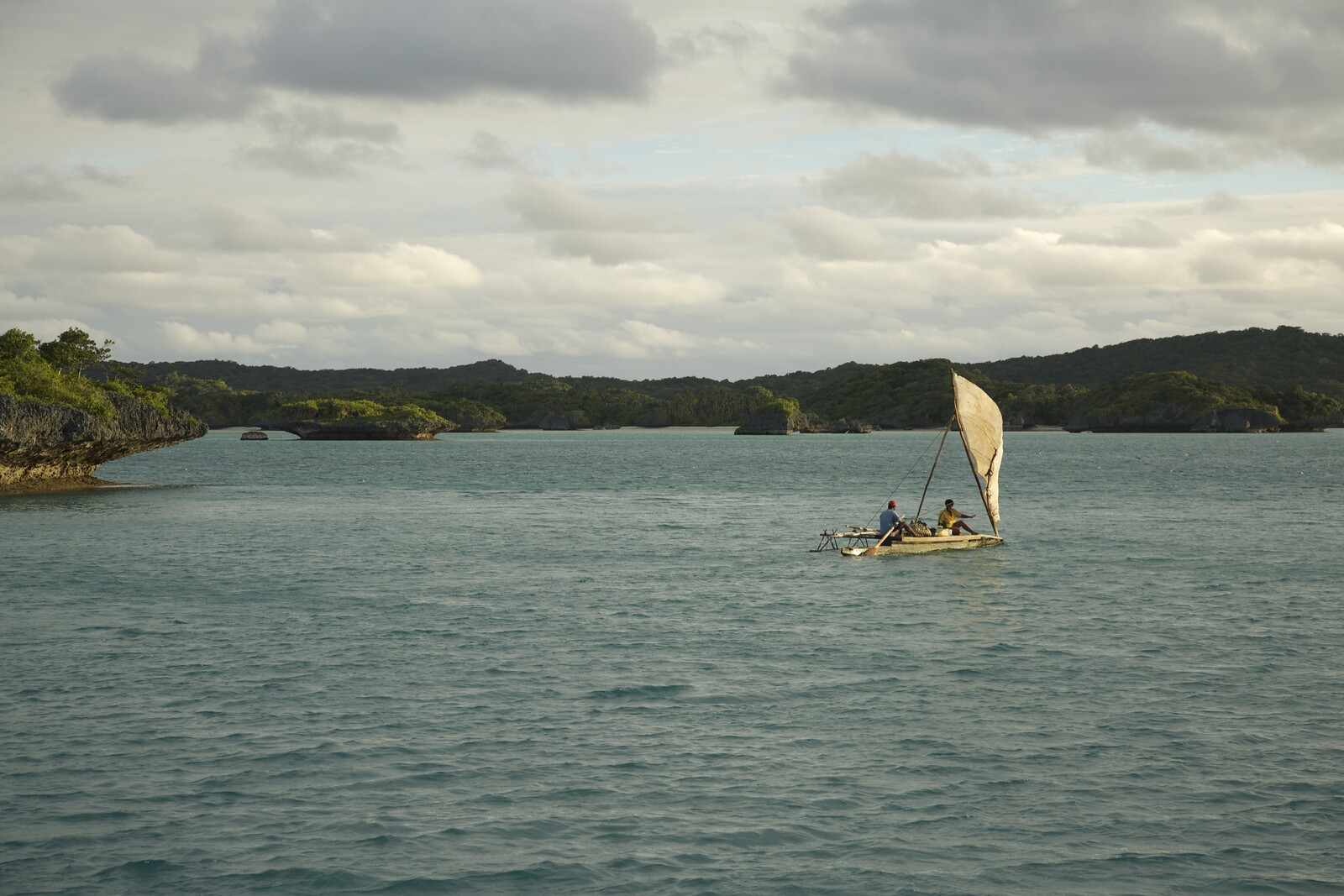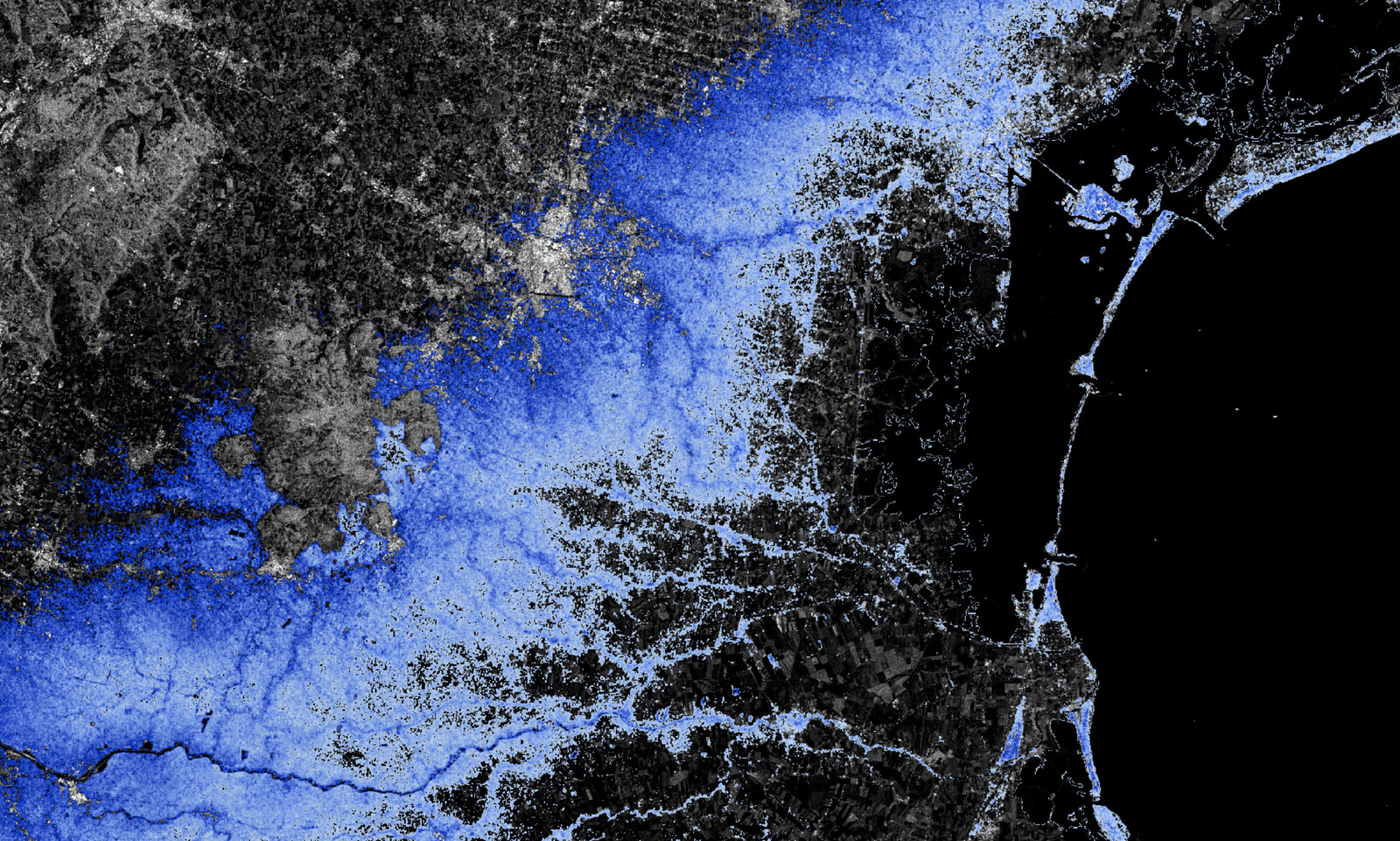Ears Up Sound Design. Healthy Ocean (From Sounds Too Many), 2019. Courtesy of Francesca Thyssen-Bornemisza and TBA21–Academy.
Frequency Fishing
It’s only when we dive that we understand.
—Pak Harun Mohamad1
“[To] get a sense in air of [a dolphin echolocating], blow on your hand: it’s how it feels underwater to feel the sounds on your skin, on your body,” sound artist Jana Winderen tells me. The sensation is likely familiar to practitioners of Dulam, the ancient, now-endangered art of fish listening, which is still practiced by a handful of expert individuals in Muslim fishing communities along the Southern Coast of the Gulf of Thailand, in the Songkhla Province, and in the Setiu Wetland Lagoon in Terengganu, Malaysia, that borders the South China Sea.2 In lithe amphibious choreographies, fish listeners submerge themselves a meter or two below the water’s surface, arms outstretched as if antennae, to listen through their skin, skull, and bones for the vibration and sounds of fish movement, direction, and even species type. Piscine position divined, sometimes up to fifty dives later, fish listeners gesture a summons to fishermen on boats—located a couple kilometers away, their engines off to avoid sonic interference—who encircle the indicated spot and drop their nets in tandem.3
Such practices of hearing underwater are a kind of vibrotactile musicking with the skin: the nearest perceptual equivalent to the liquid pressures and lifeworlds of fishes themselves. “Being a fish listener means learning first from the fish,” Pak Harun Mohamad, a fish listener active in Malaysia’s Setiu Lagoon, encapsulates. “Nobody can teach us this art. We learn from the fish themselves.”
Tuning to and with marine life is no small feat, for unlike highly adapted marine species with diverse mechanisms for bodily sound production and reception, humans are, for the most part, effectively deaf-mute underwater.4 Water is a medium so dense that sound waves propagate around 4.8 times faster than in air, and sometimes span vast distances with little energy dissipation. Though liquid-filled—a bioevolutionary nod to aquatic antecedence and time spent in the womb, where hearing is the first sense to develop (through amniotic fluid)—our inner ears have since evolved to tune to air pressure, and our voices to speak through it.5 For marine species, on the other hand, water’s high sonic metabolism plays both microphone and hearing aid to their chatter.
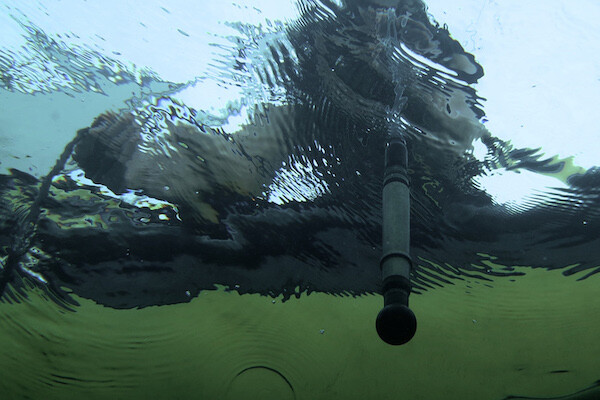

From the making of bára: Hydrophone recordings in the waters off Panama, 2013. Part of Jana Winderen, bára, 2017; commissioned by TBA21–Academy, from Thyssen-Bornemisza Art Contemporary Collection.
Not readily apprehensible (at least to non-fish listeners), prosthetic technologies of translation can serve as substitute sensors of underwater realms, which are, to Stefan Helmreich, less “soundscape” than “soundstate,” or “zone[s] of sonic immanence and intensity.”6 Aqueous milieus can be transduced into perceptibility above sea level—whether for imaging, informatics, or imagination—but always as a “‘more-than-human’ assemblage.”7 Attending to underwater (un)sound helps unfurl a dynamic tapestry of affect and amplification, and to gage the extent to which anthropogenic sound inputs, or what bioacoustician Michel André dubs “acoustic load,” penetrate and perturb the sensory ecologies of underwater lifeforms. To listen with “anthroposonic” ears to the mechanisms, shifting thresholds, and critical bandwidths of underwater sound production and reception in marine species themselves can help us fathom and hear through how an aesthetics of sensation underwater may be at stake due to sustained acoustic trauma.8
Ears Up Sound Design. Cacophony of Ships (From Sounds Too Many), 2019. Courtesy of Francesca Thyssen-Bornemisza and TBA21–Academy.
Bleaching Bandwidths
We divers who use our ears, we’re better than sonar. [Sonar] can’t tell you what kinds of fish are there. If [sonar] was that good, it could compete with us, ear folk.
—Ayahku Tengku Mahmood9
The field of underwater acoustics is intricately wound with multiple registers of vibration, sound, and noise: a collective enmeshing of microbial and mammalian marine species’ vocalizations (biophony), geophysical movements (geophony), tidal currents, glacial melt, and anthropogenic technologies of construction, extraction, circulation, and censorship (anthropophony). Biotic resonances in this sensorial environment are often masked from without, as manmade frequencies, usually tangential, mount over each other just as they descend below the surface. Undersea naval research, militarized surveillance, offshore industrial activity, large-scale fishing, and leisure economies all impose acoustic baggage of varying durations and intensities.
The ocean’s own underwater frequencies have, meanwhile, performed as mapping agents from the early twentieth century onwards, when analogue methods of surveying the ocean floor with weighted sounding lines were replaced by Sound Navigation and Ranging (sonar). A form of acoustic remote sensing and echolocation, sonar deploys “nature-identical” techniques of sound propagation and reception through hydrophones, usually at infra- or ultrasonic frequencies, to navigate, map, communicate with, and detect objects underwater—whether other vessels, marine life, or seabed topology—in both military and commercial applications.10
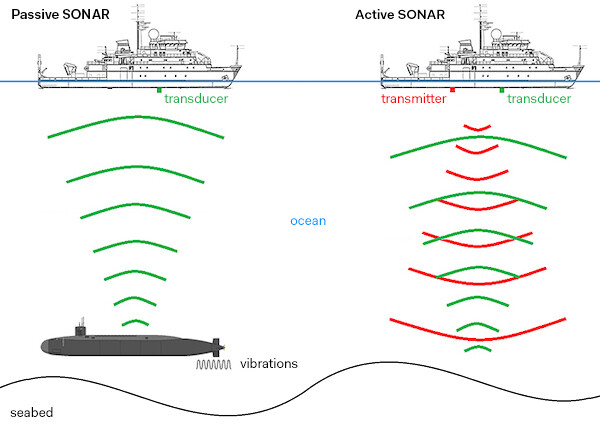

Diagrams of passive and active sonar, courtesy of The Mariners Museum.
Ears Up Sound Design. Sperm Whales/SONAR (From Sounds Too Many), 2019. Courtesy of Francesca Thyssen-Bornemisza and TBA21–Academy.
Active sonar emits directional “ping” sounds, registering reflected echoes to calculate distance, while passive sonar only listens for extant sounds made by objects or animals. Long-term passive sonar arrays are used by oceanographers to study and monitor the presence, movements, and sounds of marine species populations and their milieus.11 While the job of listening for echo reflection was, historically, conducted by sonar technicians, unmanned undersea vessels and sensor-packed drones increasingly operate today as prosthetic listening devices in their stead.12
During World War II and the Cold War, underwater listening technologies intertwined the fields of military oceanography and marine biology. “In the oceanic soundscape, marine life was [originally] approached through an epistemology of error,” Alexandra Hui and Lino Camprubi write. “Plankton stood in the way of sound waves, shrimps distorted hydrophone receptions, and whales emitted enigmatically unclassifiable sounds that questioned existing sound signature catalogues of Soviet vessels.”13 Marine sounds were, however, eventually codified by marine biologists as scientific objects of “informational enrichment,” providing “a continuity between the secret search for errors and open practice of marine mammals and fishery studies.”14
Steve Goodman reads sonar as an instantiation of “military urbanism’s ‘full spectrum dominance,’” implicating “into the field of power the dimension of unsound, of frequencies just outside the periphery of human audibility, infrasound, and ultrasound.”15 The “logistics of (im)perception” deployed by sonar techniques, he writes, encompass a “perceptual prosthetics: an extension and an amputation.”16 Sonar is, however, only one of a swath of underwater noise-polluting technologies. Sound emission is a non-integral by-product in excess of many offshore industrial activities, including seismic airgun blasts that are used to prospect for oil, gas, and rare earth elements below the seabed, piledriving, windfarm construction, and shipping traffic.17


Electron microscope images of Sepia officinalis. Control specimens not exposed to sound: (a) normal sensory epithelium and (c) apex of a normal hair cell. (b) Immediately after sound exposure, hair cells show bending and disorganized kinocilia. (d) 48 hours after sound exposure, apex of a severely damaged hair cell. From Michel André et al., “Low-frequency sounds induce acoustic trauma in cephalopods,” Frontiers in Ecology and the Environment 9, no. 9 (2011): 489–493.
Ears Up Sound Design. Plunge and Sperm Whales (From Sounds Too Many), 2019. Courtesy of Francesca Thyssen-Bornemisza and TBA21–Academy.
Lacking coordinated sound exposure criteria, few comprehensive legal frameworks exist outside of the EU’s Marine Strategy Framework Directive and the International Maritime Organization’s noise level limits set out in the International Convention for the Safety of Life at Sea. This comes, in part, due to the problem of finding not only conclusive, but also causal, evidence of acoustic trauma in marine species. Whales, for instance, often disperse when faced with loud noise, and in studying cases of mass strandings, one “almost has to be there when the animal dies” in order to delicately extract the inner ear before tissue corrodes for it to satisfy lab criteria. Michel André’s Laboratory of Applied Bioacoustics at the Technical University of Catalonia did, however, find evidence of permanent sensory damage from seismic air gun explosions in cuttlefish, who, unlike cetaceans, tend to wait for sound sources to dissipate. (Invertebrates’ generally limited motility makes escaping noise disturbance difficult.)18
Christopher Clark, Director of the Bioacoustics Research Program at Cornell University, usefully describes offshore ocean space as “urbanized”—an infrastructure space so intensely trafficked by commercial vessels as to produce “acoustic bleaching,” wherein whales and other marine species can no longer navigate via vocalizations, often their primary means.19 Clark’s research on North American Right Whale calls and counter-calls indicate an “acoustic habitat loss” in their communication field of up to 85% from shipping traffic.20 Shipping traffic, in displacing speech patterns, effectively hacks into and overwrites cetaceans’ own frequency bandwidths. The phenomenon is exacerbated by chemical shifts in seawater due to acidification, which changes the actual structure of water and effects how, and how far, sounds propagate. Acidity retunes its carrier medium.
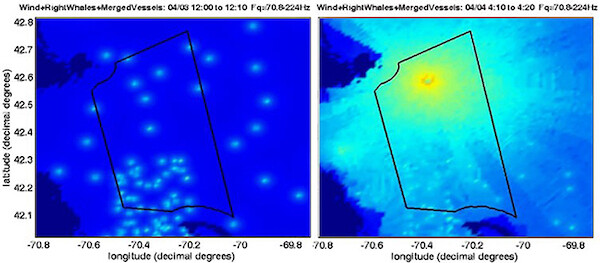

Whale sound signatures in the Cape Cod-Boston region without the presence of ships (left) and “bleached” by a single commercial ship entering Boston Harbor. Image by Dimitri Ponirakis.
Ears Up Sound Design. Orcas Interrupted by Large Vessel (From Sounds Too Many), 2019. Courtesy of Francesca Thyssen-Bornemisza and TBA21–Academy.
Around thirty percent of all anthropogenic carbon dioxide emitted mixes with seawater, after which chemical changes break CO2 molecules down into parts. When water and CO2 combine to form carbonic acid (H2CO3), hydrogen ions—whose concentrations calibrate seawater acidity—are released. (Higher hydrogen concentrations mean higher acidity, or lower pH).21 Studies have shown that acidified seawater, with lower pH, absorbs less low-frequency sound.22 One global ocean-model study predicted that the chemical absorption of sound will almost halve in regions with high levels of industrial activity, such as the North Atlantic Ocean, over the course of the twenty-first century, and could fall by sixty percent in both deep and high latitudes over the next three centuries.23
Changes in seawater pH levels can affect physiological mechanisms in marine lifeforms that drive behavioral responses integral for survival. Marine mammals and fishes (and invertebrates via different organ structures) use sound to orient themselves sensorily. Acoustic particle motion is, schematically, perceived through their bodies, across their mechanosensory lateral line, bone structure, swim bladder (if they possess one), and onto cilia in the otolith or inner ear. These nuanced, multimodal trajectories differ widely across species, and move from aural to haptic conceptions of hearing processes. Sound retains biological importance throughout marine lifespans, too, in communicating, mating, spawning, and even settling as larvae—where certain sounds act as attractor elements, especially within coral reef environments’ “sensory halos,” or distance detection zones.24
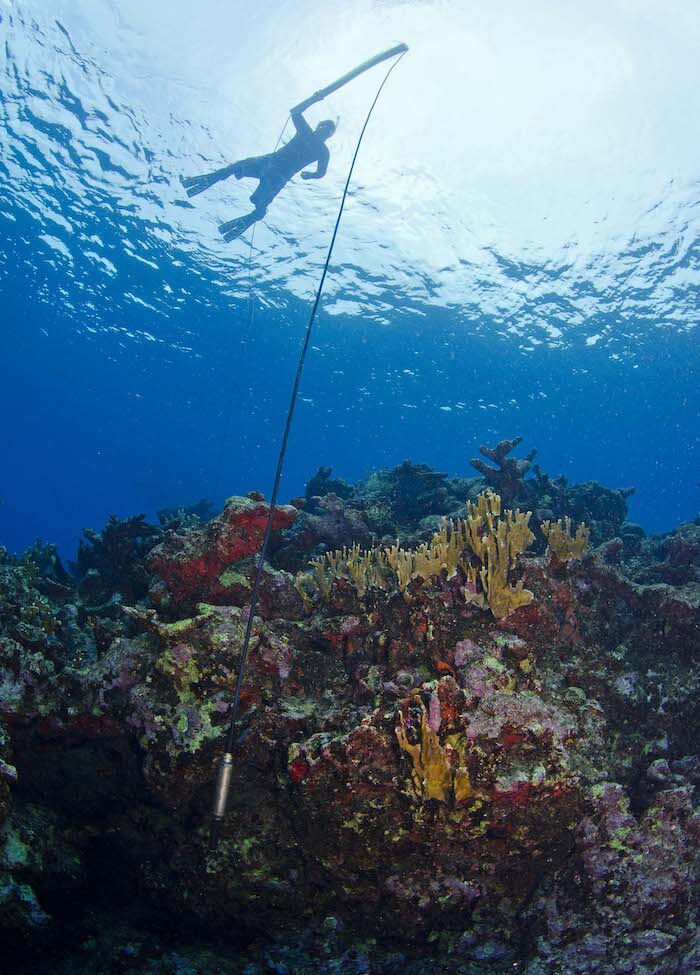

From the making of bára: Hydrophone recordings at the Silver Bank, Dominican Republic, 2013. Photo by José Alejandro Álvarez. Part of Jana Winderen, bára, 2017. Commissioned by TBA21–Academy, from Thyssen-Bornemisza Art Contemporary Collection.
Jana Winderen, Spring Bloom in the Marginal Ice Zone. Published by Touch Music/Fairwood Music UK Ltd.
Silencing of the Reefs
To negotiate with the scallops is to first negotiate with the currents…The researchers are ready to make any kind of concession in order to lure the larvae into their trap. What sort of substances do the larvae prefer to anchor themselves on?
—Michel Callon25
Complex underwater ecosystems, coral reefs are metaorganisms found in paradoxically nutrient-low marine waters, with little nitrogen or phosphorus. Their “proliferative scaffoldings,” like rainforests, support millions of species—and nourish their usually lush soundscapes, too. Indexing species in parts of the Great Barrier Reef, scientists estimated that reefs host at least a million species, and possibly as many as nine million, distributed across their mycelial nexuses.26 Some 25% of marine life is dependent on reef environments, and above sea level, around half a billion humans rely on reef-related economies.27
A reef’s chief scaffold-builders are coral polyps: miniscule marine animals that secrete exoskeletons around a central mouth of calcium carbonate to protect their soft, tentacled bodies, into which they might retreat. These organisms live in symbiosis with zooxanthellae, a kind of photosynthetic algae found within them that help deliver nutrients, which, in turn, speed calcification.28 A structurally healthy reef, and the noisy marine life that it plays host to by extension, depends on the metabolic matterings of this foundational interspecies rapport.
Interested in whether reef soundscapes resembled those of stridulating river insects, whose presences can aid in detecting the health of a river, Winderen set out in 2011 to accrue recordings from shallow-water reefs in Belize, Panama, and the Dominican Republic.29 By “fishing for sound,” Winderen sought to probe her interrelated intuition that reefs’ very particular bioacoustic signatures could indicate their ecological health over time, as well as observe illegal fishing’s effects on reef regrowth. That sound is crucial to the vitality of underwater lifeforms and their milieus, in general, finds concentrated expression in coral reefs, where auditory cues include inducing larval fish settlement, and make Winderen’s sited “sound research” especially pertinent as reef environments become fragilized by mass coral bleaching, impaired rates of calcification, and illegal overfishing, all against mounting anthropophonic ocean noise.30
Built of symbiont organisms, a coral reef is rich in instances of additive acoustic behavior, as if an underwater Babel. Recording in reefs in the Silver Bank, Dominican Republic, Winderen observed that whales had located themselves near cliff faces with echoic acoustic properties, too, and that they were responding to their own songs’ sounds. An overheard moment of musicking and composition, it might be read as an “extended phenotype,” or niche construction, wherein an organism expresses or instrumentalizes itself beyond the framework of its body. Where such worlding processes of acoustic habitat production become hampered, curtailed, or overwritten by external forces, an aesthetics of impoverished sensation and communicability among marine species may ensue.
Interarticulated with scientific findings, recordings such as Winderen’s help bear aural witness to the emergence of a certain environmentalization, toxification even, in sensory scaffolds. As a countermeasure to such phenomena, stethoscopically “sounding” reef environments might (re)tune us to thresholds of underwater unheards, while serving as a crucial technology of marine species identification, and for observing complex auditory behaviors in situ. With an ear to the hydrophone, Winderen’s project attempts to document nonhuman sound-worlds and render species’ “sound signatures” on a per-reef basis, aware that, “as species die out, so too does their sound imprint without us knowing that they ever existed, before we are even close to understanding them and their habitats.”31 Listening with Winderen’s recordings and ambisonic installations can, in such ways, bring us near to the wet languages and languaging of multispecies vibration alongside those pressures that trouble their passage.
Fish Listeners of Setiu Lagoons, directed by Dain Iskandar Said (Malaysia: Apparat, 2018).
The Thai government’s plans to transform the Chana District into a “Southern Economic Corridor,” industrial city, and deep-sea port would devastate local fishing communities’ livelihoods and ways of life. These communities restored depleted coastal ecologies some thirty years ago by constructing artificial reefs. Their protests have been quelled by military force.
Sounds Too Many is a lecture-performance by Francesca Thyssen-Bornemisza. This primarily acoustic presentation creates an immersive experience that calls into question the unlimited and unregulated sonic pollution that the Anthropocene era has imposed on our oceans and the disruption that this causes to all natural phenomena. It is a call for a quieter ocean. In collaboration with the Acoustic Ecology Laboratory at Scripps Institution of Oceanography, the award-winning NRDC documentary Sonic Sea, TBA21–Academy expeditions, the sound artist Jana Winderen, and other contributors, never-before-heard sounds had been spatialized by sound engineers from Ears Up Sound Design Studio in Burbank, California, in partnership with Meyer Sound Laboratories, to create this immersive soundscape. Visualizations by Territorial Agency are tightly synchronized with the soundscapes to provide visceral insights into the scale and mechanics of the ecological threat that is sound pollution in the ocean. For more information, see ➝.
Exceptions trouble such species limitations, as Jana Winderen noted in a conversation with the author on July 24, 2020. Certain “sea gypsy” groups, such as the Moken, have evolved underwater sight, while Samau-Bajau populations’ larger spleens permit prolonged submersion when free-diving.
Vocalizing underwater is possible, but requires the skilled manipulation of air pressure shifts, bubble noise, and bone conduction.
Stefan Helmreich, “Listening Against Soundscapes,” Anthropology News, December 2010, 10, ➝.
Philip Steinberg, “Of Other Seas: Metaphors and Materialities in Maritime Regions,” Atlantic Studies 10 (2013): 156.
I cite Lendl Barcelos’s elaboration of the “anthroposonic.” See Lendl Barcelos, “The Nuclear Sonic: Listening to Millenial Matter,” in Aesthetics After Finitude, eds. Amy Ireland, Baylee Brits, and Prudence Gibson (Sydney: Re.press, 2016), 72.
Fish Listeners of Setiu Lagoons, Said.
Winderen notes the need for multidisciplinary efforts to map the spawning areas of various species, etc., so that sonar-navigated shipping traffic can avoid them.
As in Listening to the Deep Ocean Environment (LIDO), as well as in planetary-scale ocean surveillance schemes, such as SOSUS (Sound Surveillance System), a still-operational Cold War submarine detection initiative.
Jeremy Page, “Underwater Drones Join Microphones to Listen for Chinese Nuclear Submarines,” Wall Street Journal, October 14, 2014, ➝.
Lino Camprubi and Alexandra Hui, “Testing the Underwater Ear: Hearing, Standardizing, and Classifying Marine Sounds during the Cold War,” conference paper, Testing Hearing: Science, Art, Industry, Max Planck Institute for the History of Science, Germany, December 4–5, 2015.
Susan Schuppli cites geographer Andrew Barry’s notion of “informational enrichment” in her book. See Susan Schuppli, Material Witness: Media, Forensics, Evidence (Cambridge: MIT Press, 2020), 7; Camprubi and Hui, “Testing the Underwater Ear.”
Steve Goodman, Sonic Warfare: Sound, Affect, and the Ecology of Fear (Cambridge: MIT Press, 2010), 17.
Ibid., 35–37.
Global shipping traffic has increased some three hundred percent since 1992. Laura Cole, “Sound Argument,” Geographical, October 15, 2015.
Michel André in conversation with the author on July 24, 2020.
Krishna Ramanujan, “Acoustic maps of ocean noise reveal how shipping traffic affects whales,” Cornell Chronicle, February 22, 2010, ➝.
Daniel Stolte, “Blinded by the Noise,” Science, February 23, 2010, ➝.
The Ocean Portal Team, “Ocean Acidification,” Smithsonian, 2018, ➝.
Katherine Harmon, “Could Ocean Acidification Deafen Dolphins?” Scientific American, December 20, 2009, ➝.
Geochemist Tatiana Ilyina frames this as the “less anticipated consequence of ocean acidification.” Ibid.
Edward A. Codling, Adam J. Hill, Julius Percy, and Stephen D. Simpson, “Habitat quality affects sound production and likely distance of detection of coral reefs,” Marine Ecology Progress Series 516 (2014): 35–47.
Michel Callon, “Some Elements of a Sociology of Translation: Domestication of the Scallops and the Fishermen at St Brieuc’s Bay,” in Power, Action and Belief: A New Sociology of Knowledge? ed. John Law (London: Routledge, 1986), 11.
Elizabeth Kolbert, “Unnatural Selection,” The New Yorker, April 18, 2016, 22–26.
See “Why are Coral Reefs Important?” in: “Basic Information about Coral Reefs,” Environmental Protection Agency, ➝.
A solidarity economy populated by what Donna Haraway would call “compound” figures. Stefan Helmreich, Sounding the Limits of Life: Essays in the Anthropology of Biology and Beyond (Princeton: Princeton University Press, 2016), 49–54.
“Silencing of the Reefs” was commissioned by TBA21–Academy and research was conducted on Dardanella.
Degraded reef environments sustain correspondingly less vocal activity among resident fishes, emerging “acoustic sample” studies have shown. Certain recent studies trial “playing back” biological sounds in degraded reefs to test for improved larval settlement rates and other markers of reef replenishment.
“Jana Winderen, Silencing of the Reefs, 2011,” TBA21, ➝.
Oceans in Transformation is a collaboration between TBA21–Academy and e-flux Architecture within the context of the eponymous exhibition at Ocean Space in Venice by Territorial Agency and its manifestation on Ocean Archive.
Category
Subject
Oceans in Transformation is a collaboration between TBA21–Academy and e-flux Architecture within the context of the eponymous exhibition at Ocean Space in Venice by Territorial Agency and its manifestation on Ocean Archive.
